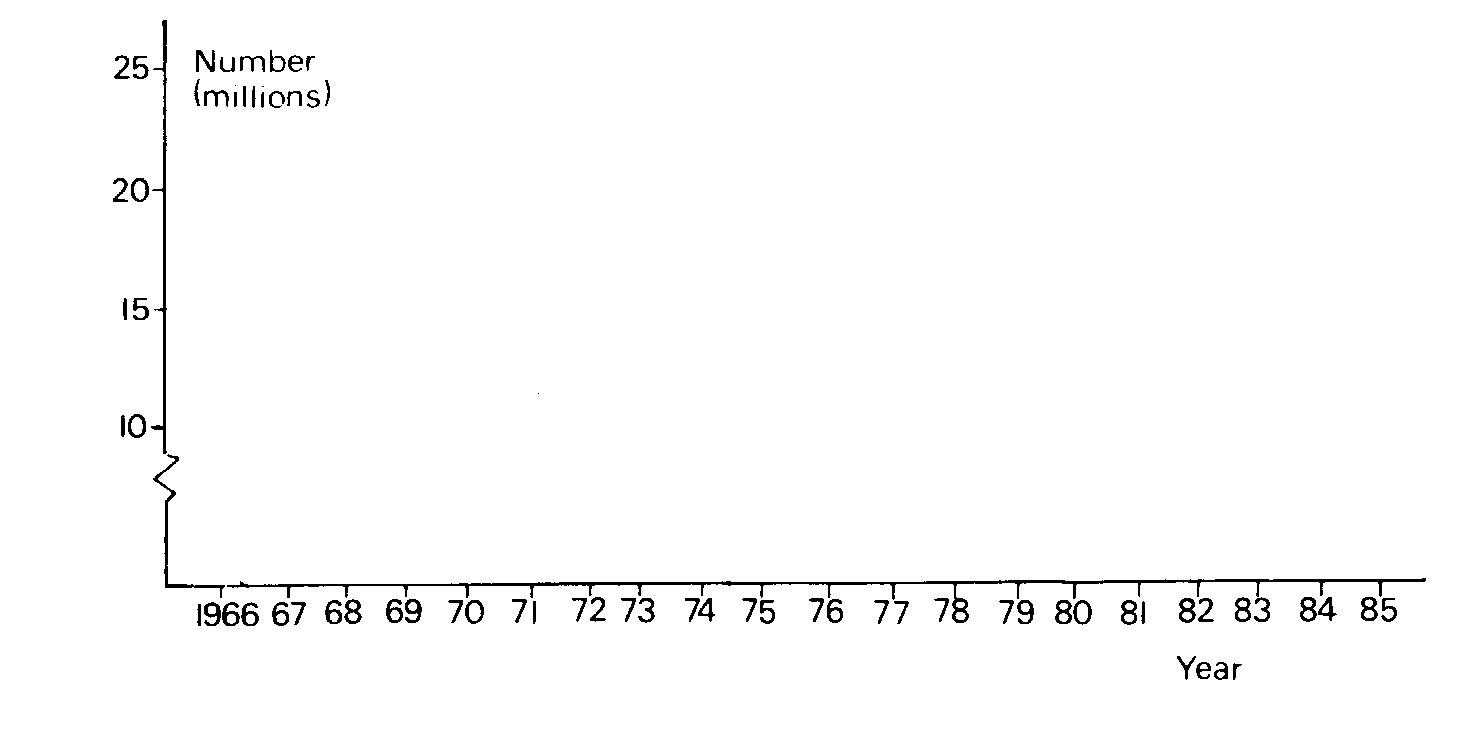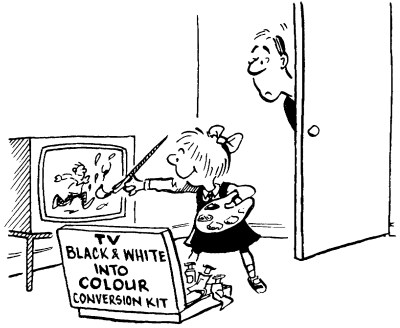| Television
Licences
Television was invented less than fifty years ago.
Nowadays most households have a television. Table 1 shows the growing number of homes
licensed to watch television in the period 1966 to 1974.
(Source: Annual Abstracts)
Table 1 - Television licences current in the U.K. (March 31)(Millions).
Remember that the figures are in millions.
- Write down how many licences were current in 1966 and in 1974.
- How many more Licences were current in 1974 than in 1966?
- Use your answer to b to work out the mean number of extra licences issued each year over
this period.
- About how many licences do you think were issued in 1975?
Who might need to know?
- Do the figures in Table 1 show how many people watch television?
Explain your answer.
Predicting
from a Graph
It is often easier to predict the future by using a graph.
- Choose a suitable scale and copy Figure 1.
The horizontal scale should run from 1966 to 1985, the vertical scale from 10-25
million. (Why not 0-25 million?)
The zig-zag on the vertical axis is to show that the scale starts at 10 million and not
at 0.
Make sure the axes are labelled.

Figure 1 - Axes for 'Television licences'.
- Plot the points from
Table 1 on your graph. Give your graph a
title.
Are the points nearly in a straight line? If not, check that you have plotted them
correctly.
Use a (transparent) ruler to find the straight line which you think passes closest to
most of the marked points. Some of the points should be above the fine, others below. Draw
this line in pencil. Extend your line past 1974.
According to the line you have drawn, how many licences were issued in 1969? It should
be between 15 and 16 million.
Use your line to predict the number of licences in 1975, 1977 and 1985.
Checking
Predictions
In fact there were 17.7 million licences in 1975 and 18.0 million licences in 1977 (17.701
million in 1975 and 17.994 million in 1977).
- Find the differences between your estimates in B2f and the true figures.
These differences are called ERRORS.
- Which estimate had the largest error? Why do you think this is so?
The graph shows that the number of licences issued has increased since 1966.
- Do you think that the number of licences will go on increasing?
Give reasons and use figures to support your answer.
*Estimates
and their Limits
Estimates can never be exact. When estimating, It is useful to give a range of values
between which the actual value is likely to lie.
Here is one method to work out the range for 1975.
The smallest yearly increase in Table 1 is 0. 1 million, from 1970 to 1971. It is
reasonable to assume that the increase from 1974 to 1975 will not be less. So we predict
the number of licences in 1975 will be at least 17.3 + 0.1 million = 17.4 million.
- In a similar way find the largest annual increase in Table 1. Use it to predict the
highest number of licences likely in 1975. Does the estimate you made for 1975 in B2f lie
between these highest and lowest values?
- Using your answers to B4a, work out corresponding highest and lowest estimates for 1976
and 1977. Does the estimate you made for 1977 in B2f lie between these values?
- Copy and complete:
If the number of current television licences continued to grow in the same way as it had
over the previous nine years, I would expect there were at least _____ million and at the
most _____ million licences held in 1977.
Colour v
Black-and-White
It is not always possible to draw a straight line which closely fits the points.
Sometimes a smooth curve can be used instead. It is unlikely that any smooth curve will
pass through all the points. Instead we look for a smooth curve which passes close to most
of the marked points.
Here is such a case. More and more people are switching to colour television. This is
shown in Table 2.
| Year |
1967 |
1968 |
1969 |
1970 |
1971 |
1972 |
1973 |
1974 |
1975 |
| Colour |
0 |
0.02 |
0.1 |
0.3 |
0.6 |
1.6 |
3.3 |
5.6 |
7.6 |
Black-
and-
white |
14.3 |
15.1 |
15.4 |
15.6 |
15.4 |
15.1 |
13.8 |
11.7 |
10.1 |
(Source: Annual Abstracts)
Table 2 - Television licences current in the U.K. (March 31) (Millions).
- Choose a suitable scale to plot the figures in Table 2. Mark your
horizontal axis from 1967 to 1980.
- Plot the points showing the number of colour licences. Draw in a smooth curve which
passes close to the points.
- Look carefully at the shape of the curve you have drawn. Keeping the shape of the curve
in mind, extend it past 1975.
- How many colour licences do you expect in 1980?
- On the same graph plot the number of black-and-white licences. Draw in a suitable smooth
curve.
Extend it past 1975.
- In which year do you predict there will be more colour than black-and-white licences?
- Comment on the trend in licences in the late sixties and early seventies. Give reasons
and use figures to support your answer.

|